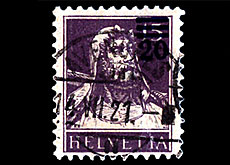Tell’s postal emancipation

The German Post Office has put its stamp on the Schiller-Tell anniversary – unlike its Swiss counterpart.
Swiss philatelists have for years thought that Tell stamps issued by their country’s Post Office are hardly worth collecting.
The national epic of William Tell will survive with or without a commemorative Swiss stamp.
But at one time, Tell did play a role in Swiss philately. In fact, Tell and his son Walter helped ring in an era of postal emancipation.
The Swiss cross was printed on stamps beginning in 1849, but was replaced by lady “Helvetia” from 1854 onwards.
At first she was portrayed with dishevelled hair, before giving way to a more demure version, the “sitting Helvetia”.
Lady “Helvetia”
The different versions of the “standing Helvetia” issued between 1882 and 1907 were – and still are – popular among stamp collectors.
A commemorative Helvetia stamp was released to mark the anniversary of the Universal Postal Union in 1900.
A few years later the Post Office saw fit to re-release a stamp displaying the Swiss emblem.
But portrayals of men were conspicuously absent.
This came to an end in 1907, when a picture of Tell’s son Walter behind an outsized crossbow found its way onto two-, three- and five-centime stamps.
However, the Post Office came in for criticism for the way the crossbow was depicted.
This first edition was replaced after only two years by a version showing Tell’s son on top of a small pedestal, without any other distractions.
Three different versions of this stamp came out between 1909 and 1911, and the third stayed in print until 1933, being reissued time and again in different colours.
Tell stamps his mark
Walter paved the way for William, who finally appeared on a Swiss stamp in 1914, replacing a bust of Helvetia.
Not willing to take any chances artistically, the Post Office chose an image of Tell that was a reproduction of the national monument of the Swiss hero, which stands in the town of Altdorf. It appeared on 10-, 12- and 15-centime stamps.
The so-called Type I – a red, 10-centime stamp – is much sought after by collectors, and is worth up to SFr400 ($320).
The most expensive Tell stamp ever issued dates from 1920. It has the overprint “20” on a black, violet 15-centime stamp. This rare example is worth SFr15,000.
Many versions
The Zumstein stamp catalogue lists 28 different versions of Tell stamps issued before 1933, and there are a further 27 with the overprint of various public offices and international organisations.
And no fewer than 65 Tells were produced for collectors alone, including pairs of stamps separated by an empty space (the most expensive goes for SFr17,500).
As if that were not enough, the Zumstein stamp catalogue lists hundreds of variations on the theme and countless misprints.
But William Tell stamps were never really that popular among philatelists.
The 10- to 30-centime stamps bearing his image were simply too common, in contrast to Helvetia, who has a lot more appeal, since she appeared on stamps up to a value of SFr3.
swissinfo, Max Frenkel
The author of the article wrote a regular philately column for the prestigious Neue Zürcher Zeitung newspaper.
The column received cult status when the author began using it to air his satirical views on politics.
He retired in 2003, and the column went into pension with him. He is now a regular contributor to the NZZ am Sonntag.

In compliance with the JTI standards
More: SWI swissinfo.ch certified by the Journalism Trust Initiative
You can find an overview of ongoing debates with our journalists here. Please join us!
If you want to start a conversation about a topic raised in this article or want to report factual errors, email us at english@swissinfo.ch.